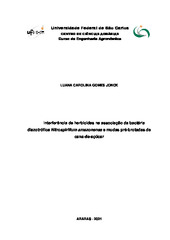| dc.contributor.author | Jonck, Luana Carolina Gomes | |
| dc.date.accessioned | 2021-12-03T16:46:48Z | eng |
| dc.date.available | 2021-12-03T16:46:48Z | eng |
| dc.date.issued | 2021-11-17 | eng |
| dc.identifier.citation | JONCK, Luana Carolina Gomes. Interferência de herbicidas na associação da bactéria diazotrófica Nitrospirillum amazonense e mudas pré-brotadas de cana-de-açúcar. 2021. Trabalho de Conclusão de Curso (Graduação em Engenharia Agronômica) – Universidade Federal de São Carlos, Araras, 2021. Disponível em: https://repositorio.ufscar.br/handle/ufscar/15253. | * |
| dc.identifier.uri | https://repositorio.ufscar.br/handle/ufscar/15253 | por |
| dc.description.abstract | The microbial inoculant for sugarcane containing Nitrospirillum amazonense cells is a recent technology and has been adopted in association with pre-sprouted seedlings to sustainably increase the crop's productivity. The objective of this work was to evaluate the sensitivity of the bacterium Nitrospirillum amazonense to imazapic and indaziflam herbicides, as well as the impact of this inoculation and herbicide treatments on pre-sprouted sugarcane seedlings. The “in vitro” sensitivity of the bacterium N. amazonense to herbicides was evaluated using the minimum inhibitory concentration technique (Assay 1). In this trial, 2 herbicides (imazapic - 200 g a.i. ha-1 and indaziflam - 100 g a.i. ha-1) in 5 doses were evaluated. In the second trial, the sensitivity of N. amazonense to imazapic and indaziflam herbicides, applied at commercial doses, in autoclaved soil was evaluated. The bacterial population count was performed using the most likely number technique (McCrady Table). In trial 3, herbicide treatments were evaluated (indaziflam, imazapic, clomazone, tebuthiuron, sulfentrazone, without herbicide), applied in pre-planting of pre-sprouted seedlings of the variety RB 966928, in the presence and absence of the inoculant N. amazonense. According to the results of the tests, the presence of indaziflam did not interfere in the in vitro growth of the bacterium N. amazonense, regardless of the dose. Imazapic caused significant inhibition of bacterial growth only at the 2DC dose. The count of the bacteria N. amazonense in the soil of the treatments that received the application of indaziflam and imazapic, did not differ in relation to the soil without herbicide. The pre-sprouted seedlings of the RB966928 variety showed high sensitivity to the herbicide imazapic, regardless of the inoculation of N. amazonense. The herbicides clomazone, tebuthiuron and sulfentrazone did not interfere in the growth promoting effect of N. amazonense. Inoculation did not change the sensitivity of pre-sprouted seedlings to herbicides. It is concluded that the herbicides evaluated in this study do not interfere in the association of pre-sprouted seedlings of the variety RB966928 with the bacterium N. amazonense, although the selectivity for seedlings is differential among the herbicides. | eng |
| dc.description.sponsorship | Fundação de Amparo à Pesquisa do Estado de São Paulo (FAPESP) | por |
| dc.language.iso | por | por |
| dc.publisher | Universidade Federal de São Carlos | por |
| dc.rights | Attribution-NonCommercial-NoDerivs 3.0 Brazil | * |
| dc.rights.uri | http://creativecommons.org/licenses/by-nc-nd/3.0/br/ | * |
| dc.subject | Bactérias promotoras de crescimento | por |
| dc.subject | Herbicidas | por |
| dc.subject | Intoxicação mudas pré brotadas | por |
| dc.subject | Growth promoting bacteria | eng |
| dc.subject | Herbicides | eng |
| dc.subject | Pre-sprouted seedlings intoxication | eng |
| dc.title | Interferência de herbicidas na associação da bactéria diazotrófica Nitrospirillum amazonense e mudas pré-brotadas de cana-de-açúcar | por |
| dc.title.alternative | Interference of herbicides in the association of the diazotrophic bacteria Nitrospirillum amazonense and pre-sprouted sugarcane seedlings | eng |
| dc.type | TCC | por |
| dc.contributor.advisor1 | Monquero, Patricia Andrea | |
| dc.contributor.advisor1Lattes | http://lattes.cnpq.br/2766526793830455 | por |
| dc.description.resumo | O inoculante microbiano para cana-de-açúcar contendo células de Nitrospirillum amazonense é uma tecnologia recente e tem sido adotada associada a mudas pré-brotadas para aumentar de forma sustentável a produtividade da cultura. O objetivo deste trabalho foi avaliar a sensibilidade da bactéria Nitrospirillum amazonense aos herbicidas imazapic e indaziflam assim como o impacto dessa inoculação e tratamentos herbicidas em mudas pré-brotadas de cana-de-açúcar. A sensibilidade “in vitro” da bactéria N. amazonense aos herbicidas foi avaliada por meio da técnica de concentração mínima inibitória (Ensaio 1). Neste ensaio foram avaliados 2 herbicidas (imazapic - 200 g i.a. ha-1 e indaziflam - 100 g i.a. ha-1) em 5 doses. No segundo ensaio foi avaliada a sensibilidade de N. amazonense aos herbicidas imazapic e indaziflam, aplicados na dose comercial, em solo autoclavado. A contagem da população bacteriana foi realizada através da técnica do número mais provável (Tabela de McCrady). No ensaio 3 foram avaliados tratamentos herbicidas (indaziflam, imazapic, clomazone, tebuthiuron, sulfentrazone, sem herbicida), aplicados em pré-plantio de mudas pré-brotadas da variedade RB 966928, na presença e ausência do inoculante N. amazonense. De acordo com os resultados dos ensaios a presença do indaziflam não interferiu no crescimento in vitro da bactéria N. amazonense, independentemente da dose. O imazapic ocasionou inibição significativa no crescimento da bactéria apenas na dose 2DC. A contagem da bactéria N. amazonense no solo dos tratamentos que receberam a aplicação de indaziflam e imazapic, não deferiu em relação ao solo sem herbicida. As mudas pré-brotadas da variedade RB966928 apresentaram alta sensibilidade ao herbicida imazapic, independentemente da inoculação de N. amazonense. Os herbicidas clomazone, tebuthiuron e sulfentrazone não interferiram no efeito promotor de crescimento de N. amazonense. A inoculação não resultou em alteração da sensibilidade das mudas pré-brotadas aos herbicidas. Conclui-se que os herbicidas avaliados neste estudo não interferem na associação de mudas pré-brotadas da variedade RB966928 com a bactéria N. amazonense, embora a seletividade para as mudas seja diferencial entre os herbicidas. | por |
| dc.publisher.initials | UFSCar | por |
| dc.subject.cnpq | CIENCIAS AGRARIAS::AGRONOMIA::FITOTECNIA | por |
| dc.description.sponsorshipId | Processo no 2020/03715-4 | por |
| dc.publisher.address | Câmpus Araras | por |
| dc.contributor.authorlattes | http://lattes.cnpq.br/5829065571164188 | por |
| dc.publisher.course | Engenharia Agronômica - EAg-Ar | por |

